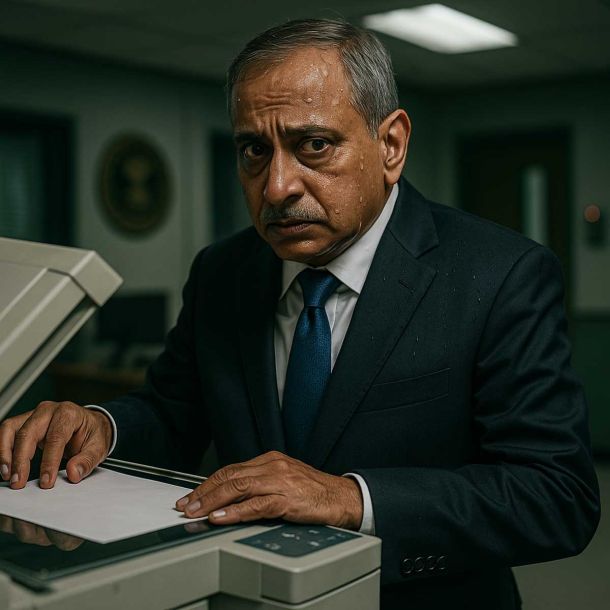More Coverage
Twitter Coverage
Satyaagrah
Written on
Satyaagrah
Written on
Satyaagrah
Written on
Satyaagrah
Written on
Satyaagrah
Written on
Join Satyaagrah Social Media
A Great man Beyond Criticism - Martyrdom of Shaheed Bhagat Singh (Some Hidden Facts)
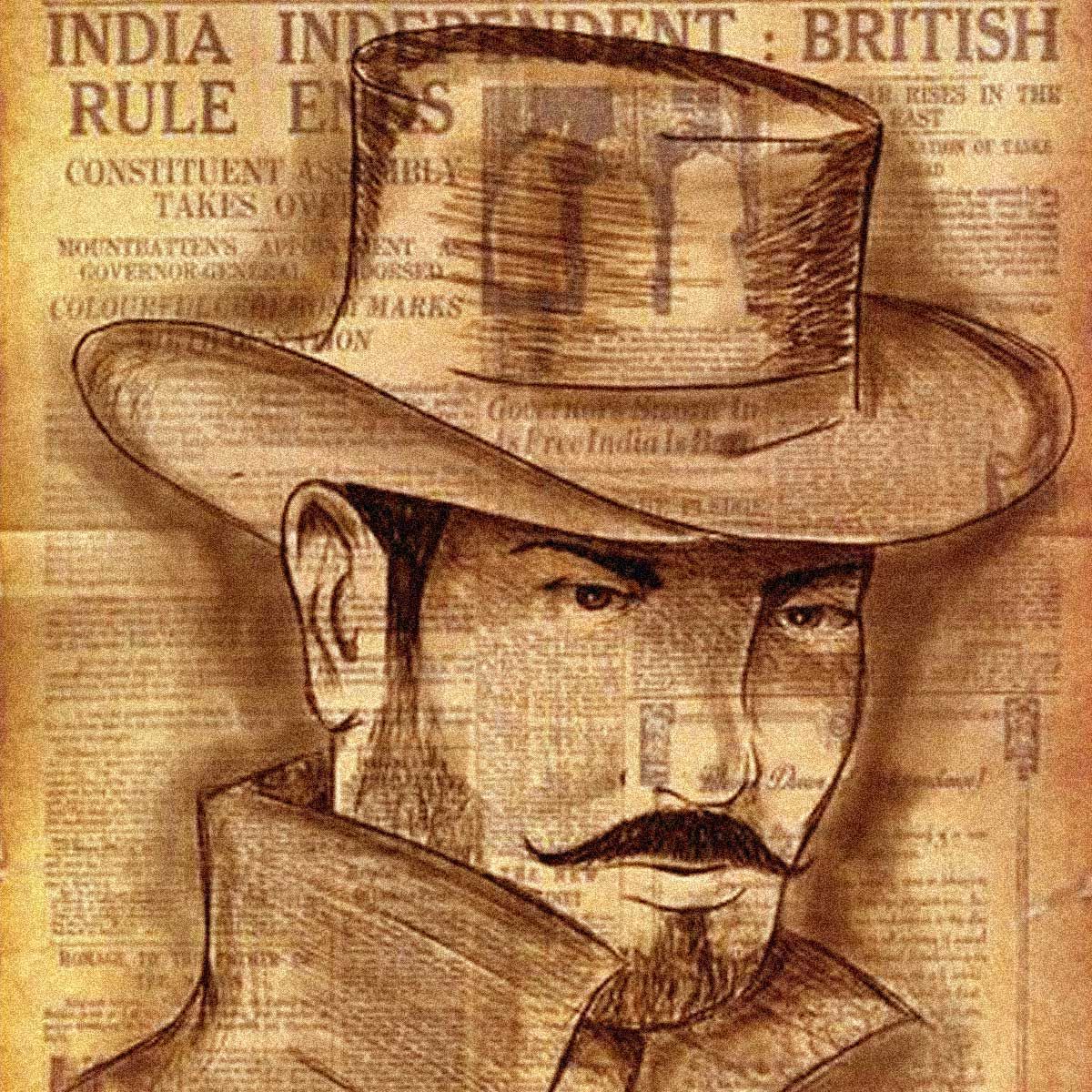
75 years ago a bomb blast occurred in the central hall of national assembly New Delhi on 8th April 1929, the echo of that bomb blast, still vibrates in the ears of many Indian who have a dream for "revolution" and those are active in political and historical circle in India. According to the text of statement of Bhagat Singh and Battu Keshwar Dutt, which was given on June 6, 1929 in the bomb-trial court "revolution" means the ultimate establishment of an order of society in which the sovereignty of the proletariat should be recognized and a world federation should redeem humanity from the bondage of capitalism and misery of Imperial Wars". This spirit of revolution motivates the down traders and frightened the Capitalist and Imperialist.
That bomb was thrown by Bhagat Singh and BK Dutt "to make the deaf hear and to give the headless a timely warning." After throwing the bomb both Bhagat Singh and Dutt offered themselves to Police arrest, as was planned by the Central Committee of Hindustan Socialistic Republic Association being headed by Chander Shekhar Azad.
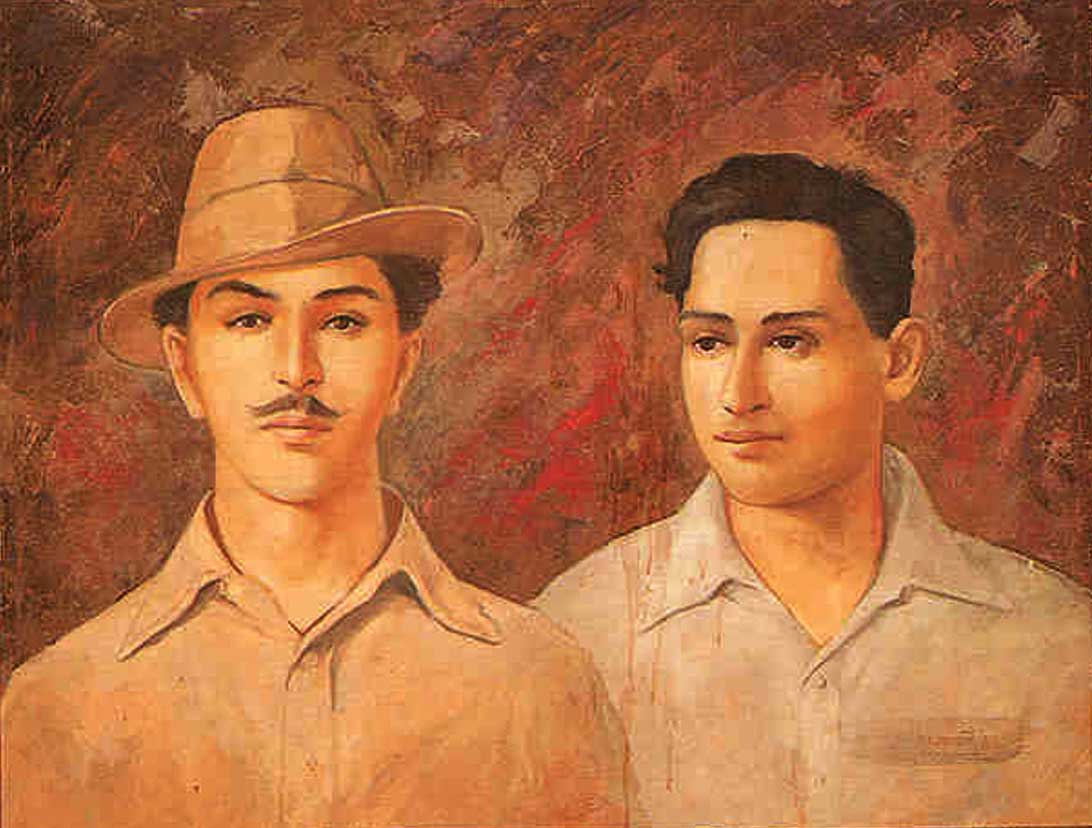 |
It was a bold and politically motivated step to propagate one's philosophy on Socialism. Bhagat Singh and BK Dutt succeeded in achieving their target through a good use of opportunity being given during judicial trial from May 7, 1929 to June 6, at Delhi 1929. At the initial stage of trial the British-Indian Police and few English Officers smelled the motto of Bhagat Singh. The policy maker of the Viceroy of India at that time took Bhagat Singh as a very dangerous young man, that is why they had tried their best to convince the judge of trial court that the throwing of bomb was aimed to kill the leader of the house so Bhagat Singh and BK Dutt must be tried under section IPCr 307, ie. attempt to murder. Defense lawyer succeeds otherwise, and judge gave his verdict under section 120-B.
Bhagat Singh and BK Dutt were sentenced to transportation for life on June 12, 1929 and both were sent to Multan jail and Lahore jail on 13th June 1929 by train. According to different files of Home Department of India related with JP Saunders Murder Case of Lahore, the Punjab Police and CID of Punjab Govt. was unable to trace the killer up to May 1929. Even the Police could not name the culprits. Only "Mr. M" was named as a suspected killer of Johan Poyantz Saunders. The Police was haunting in the dark but it was Browning Pistol No. 168096 that led the Police and CID to make a solid case against Bhagat Singh under Section IPC 302 and ultimately the British Ruler of India were successful in eliminating Bhagat Singh; a brilliant young man who put up a new model of Indian Revolution.
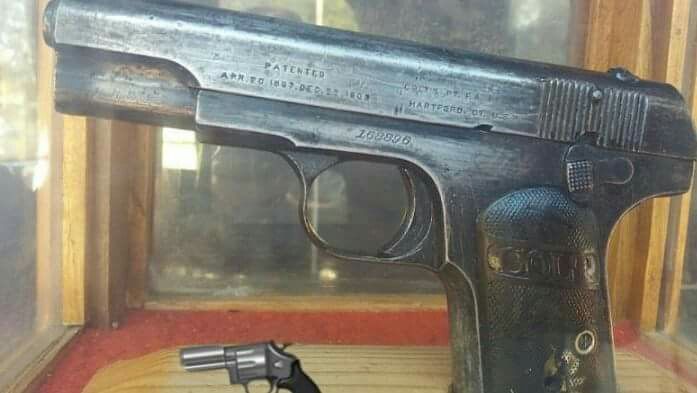 Pistol used by BHAGAT SINGH Assassinate British Police Officer John Saunders Hussainiwala Border Museum , Punjab Hussainiwal |
Although Marxism and Socialism was propagated well before the emergence of Bhagat Singh on Indian political stage by CPI (Communist Party of India), which was established in 1924 at Kanpur. More over Meerut Conspiracy Case was started against 34 leading communist leaders of India. But those leaders were putting a model of Revolution based on Russian Revolution. But it was Bhagat Singh who gave a new look to HRA (Hindustan Republic Association) and set a new goal and named it as Hindustan Socialistic Republic Association, that is why the Imperialist Ruler of India took every illegal step in the name of legal procedure of Courts to nip in the bud, the young Bhagat Singh.
If someone goes through the book "The Trial of Bhagat Singh" by AG Noorani, the conspiracy behind the Lahore Conspiracy Case can be smelled. But if someone thinks upon an Ex-Spy of British Indian Intelligence, Mr. Dalip Singh Alahabadi, who narrated various, points to Mr. Kulwant Singh Kooner of Derby, UK that was written by Kooner as rough notes. The whole story started from JP Saunders murder to the execution of Bhagat Singh, Raj Guru and Sukhdev on March 23, I 931 has to be researched and rewritten, if we accept Dalip's versions.
Before telling about the hidden truth through the eyes of Dalip Singh let us go to the story of Pistol No.168096 which was claimed to be taken into possession by the Delhi Police from Bhagat Singh at the time of their arrest from the balcony of Central Hall of the Assembly, New Delhi on 8th April, 1929 after the throwing of bomb. The act was well planned and executed, Bhagat Singh himself put up this idea at the meeting of HSRA at Agra in early March 1929. It was decided that two persons namely Ram Saran Dass and Battu Keshawer Dutt were selected to complete the action. Bhagat Singh tried his best to convince the Commander-in-chief Mr. Chander Shekher Azad that he himself is the best suitable person to give ·statements and arguments in favor of the aims and objects of HSRA. But Azad did not agree, as he did not want to loose a sharp-minded leader of the organization for a small purpose.
Again in late March 1929 another meeting of central committee of Hindustan Socialistic Republic Association was held at Agra in which Sukhdev, Chief organizer of HSRA in Punjab, strongly argued for Bhagat Singh name to be included in the action team. According to Mr. Shiv Ram Verma, a companion of Bhagat Singh and Co-excused in Lahore Conspiracy Case describe in detail how Sukhdev had convinced Bhagat Singh to do the job. Many more writers also told the same story that Sukhdev blamed Bhagat Singh that he had forgotten all his aims and ideas for a lady whom he loved very much. For this reason most of the people blame Sukhdev for the early death of Bhagat Singh. It was totally wrong. If we go through various Newspapers of that period, HSRA got more attention and publicity politically after Assembly Bomb than it got after the murder of JP Saunders. But that did not happen after Saunders murder.
The murder of John Poyantz Saunders was planned to avenge the death of Lala Lajpat Rai. It was an act of mis-identity. Actually Bhagat Singh, Rajguru went to Police Kotwali (Headquarter) Lahore to kill James Alaxander Scott then Superintendent of Police at Lahore. But Saunders appeared on the scene instead of Scott and Rajguru fired a bullet from his gun although Bhagat Singh had cautioned him that the person at target was other than Scott. Rajguru did not want to waste the opportunity to kill an Englishman so he completed the job. Both fled from the scene and escaped. The Police of Lahore haunted for the killers but in vain. Police never succeed in arresting Bhagat Singh and Rajguru if the Pistol No. 168096 did not appear on the stage.
Before unfolding the truth behind the execution of Bhagat Singh revealed by Dalip Singh, it is necessary to have a look at the situation being revealed after the formation of HSRA at Ferozshah Kotla maidan at Delhi on 8th Sept. 1928, or before.
First of all about the meeting itself. The meeting was organized under the banner of Hindustan Republic Association which was very active at that time in United Province (UP) now known as Utter Pardesh; various revolutionary organizations were working individually in Bengal, Bihar, Orrisa, Punjab, Rajisthan and Madhya Pardesh (Central Province) at that time. There was no co-ordination among them. It was Bhagat Singh who felt that if the enemy was one and the same why should we remain divided. So at least 60 delegates attended that meeting along with five women activists.
It was here that a new cell called the Hindustan Republican Army was created and Chander Shekhar Azad was appointed its Commander-in chief. Azad did not attend the meeting. But his consent was taken. Why he was appointed the Chief? These are the doubts, which were neither answered by any historian nor by the Comrades of Azad & Bhagat Singh. Sukhdev was appointed as the chief organizer of HSRA in Punjab and Bhagat Singh was assigned the duty of Co-coordinators among all the units along with Bijoy Kumar Sinha. In that meeting, Bhagat Singh was present in a dress with turban on head, turnout coat of brown colors and beard on the face at the age of 21. He was the only SIKH (outwardly). Till then he was an active member and founder member of Naujawan Bharat Sabha and his activities were noted down by the CID of Punjab Police, especially after his first police arrest on 27 May, 1927 in a false case named "Dushera Bomb Case".
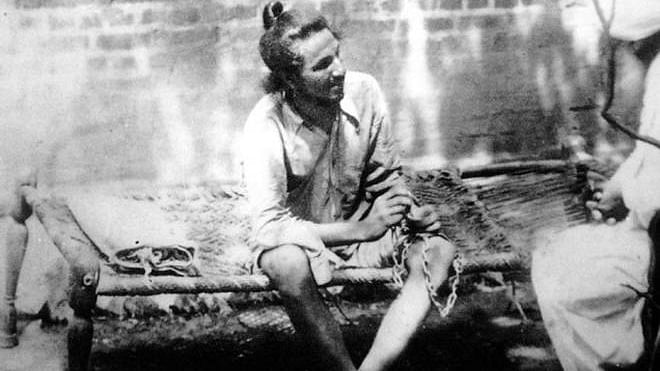 |
During the investigation of that case a photograph was taken by the CID police in which Bhagat Singh was sitting on a wooden cot, and was being interrogated by DSP CID, Sardar Gurbachan Singh of Naushera Pannuan (Amritsar District). He has a hair knot (jura) on his head and full-blown beard on his face. So Police recognized Bhagat Singh as a Sikh. After Delhi meeting it was necessary to hide that identity to deceive police eyes. It was decided by the few members of Punjab Unit of HRA to convince Bhagat Singh to cut his hair and beard. That was performed on 15-16 Sept, 1928 at Ferozpur City in the clinic of Dr. Vijay Kumar Sinha alias Dr. Gaya Parsad who himself was an active revolutionary. Jai Gopal, the policy approver later on, was also presented at that time.
Bhagat Singh then worked openly for Naujawan Bharat Sabha and Hindustan Socialistic Republic Association in Lahore before the arrival of infamous Simon Commission at Lahore. That is why the police record of that time did not have any report about Bhagat Singh after the formation of HSRA. While Sukhdev, Bhagwati Charan Vohra, Yashpal, Hansraj Vohra, Varinder, Hans Raj Sethi and Kedar Nath Sehgal etc. were prominently reported as activists of HSRA and Naujwan Bharat Sabha in Punjab.
Although Bhagat Singh took front role in organising of the procession of youth under the banner of Lahore Student Union on the eve of arrival of Simon Commission on 30th Oct. 1928. The large crowd of congress activists and other pro-independent people were lathi charged mercilessly by police on the order of then Superintendent of police Mr. JA Scott. Lala Lajpat Rai was seriously injured with lathi blows and ultimately succumbed to his injuries. Although Lala was very old and had an ill health at that time but the lathi charge was proved to be the cause of death of Lion of Punjab on 17th Nov, 1928.
The death of Lala was taken as an insult to the national pride at that time. Every one had anger in his heart especially in the hearts of youth, How to avenge this insult, was a big question?
Same question was also discussed on national level. According to Dalip Singh Allahabadi, Pt Moti Lai Nehru and Madan Mohan Malviya sent a message through their old guard Ganesh Shankar Vidyarthi of Kanpur to contact Pandit Chander Shekhar Azad. They all discussed the percussion of Lala Lajpat Rai's death. Although many differences cropped up in between Moti Lai Nehru, Madan Mohan Malviya and Lajpat Rai on the issue of Hindu Maha Sabha aims & objects, but, both Nehru & Malviya desired to use the atmosphere politically.
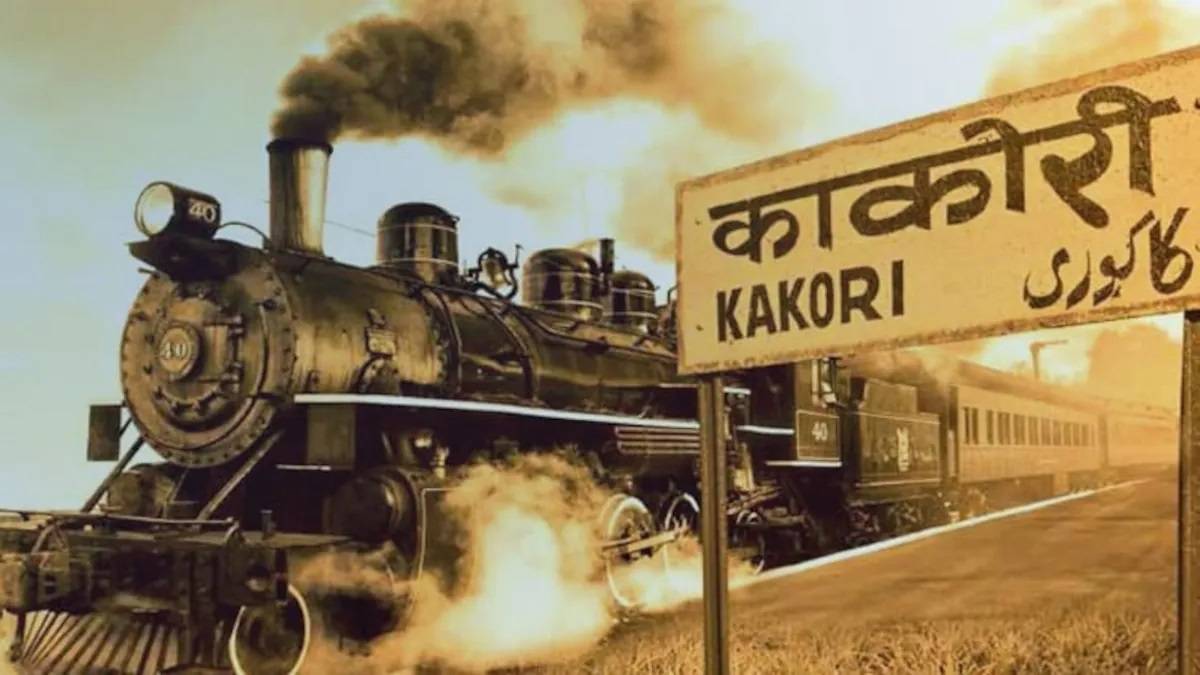 |
Even Azad also wanted a big action, as there was no revolutionary or extremist act after the hanging of four companions of Azad. Pandit Ram Parsad Bismal the founder member of HRA, Rajinder Singh Lehri, Ashafakula and Khudi Ram Bose. They all were hanged with in four days from 16th Dec 1927 to 19th Dec 1927 at different jails in India, on account of famous Kakori Train looting Case.
The dacoity of Government Treasury took place at Kakori Railway Station on 22 nd August 1925. Except Chander Shekhar Azad all others were arrested and charged with different judgments. The loss of Pt. Ram Parsad Bismal was not forgotten by Azad, so he readily accepted the proposal being put up by Ganesh Shankar Vidhyarthi, Secondly, as claimed by Dalip Singh, Azad did not agree fully with the ways the Punjab Revolutionaries were followed. Bhagat Singh and Sukhdev believed preparing the people for socialism through articles in Newspapers and schooling through literature and demonstration, where as Azad believed in violent action.
Chander Shekhar Azad, the Commander-in chief of HRA came to Punjab along with Rajguru who was famous for the accuracy of his gun target. A meeting of Punjab Unit of HSRA was held on 10th December 1928 at Mozang House, Lahore, in which full discussion was held on the ways of avenging the death of Lajpat Rai in the best traditions of "BLOOD FOR BLOOD". There was a difference of opinion. Bhagat Singh and Sukhdev did not want to kill a human being on that pretext and secondly they both were aware that after the killing they could not work for preparing the people for socialism as they had planned.
The other opinion was to kill Mr. JA Scott in daylight so that the fear of British Police could be thrown out from the hearts of people. And when some one pointed out that Punjabis are afraid of doing a daring act, Bhagat Singh angrily differed to the point and put up his name for the action. Azad assured full help and co-operation from national leaders of Indian National Congress and if there shall be arrest of any one PL Moti Lai Nehru and Pt. Jawaharlal shall fight the court case as a Barrister.
So the meeting came to an end with the proposal of date of action as 17th Dec. 1928 exactly one year after the hanging of Ram Parsad Bismal. Azad accepted the name of Bhagat Singh to hit the target. Rajguru was assigned the job to give cover to Bhagat Singh and also to shoot the target if it escaped from Bhagat Singh. If the police pursued them, Azad himself, will cover both Rajguru and Bhagat Singh during the retreat. Sukhdev has to arrange the route map of police Kotwali and a safer place for hiding after the action. Jai Gopal was deputed as a signalman. His duties were to follow JA Scott daily from his residence to office and from office to residence and note down his movements. After four days on 15th December a full rehearsal was held on the fixed spot.
Mean while on 16 th December a public meeting of Naujawan Bharat Sabha was held in Bradley hall at Lahore to celebrate the days of martyrdom of Kakori case and to pay tribute to Kartar Singh Sarabha the youngest martyr of Indian Independence. On 17th morning Jai Gopal reported at 10 am that JA Scott has left for his office. So at 4 pm was fixed the time for final action when Scott was supposed to leave his office.
According to the account being given by Dalip Singh Alahabadi to Kulwant Singh Kooner that Secret reports were received by DIB at Delhi (Directorate of Intelligence Bureau) that some old revolutionary of LLP planned an action to kill an English policeman to avenge the death of Lala Lajpat Rai. Scott was informed accordingly, that is why he changed his daily movements secretly. On the other hand CID wanted to nab the culprits if any thing happened, as was reported Scott laid a trap quietly and deputed a new and young officer JP Saunders to attend and look after the office in his absence. That is why Saunders appeared on the scene instead of Scott. According to Dalip Singh JP Saunders was, would-be-bridegroom of daughter of an English officer PA (Personnel Assistant) to the Secretary of State Govt, of Punjab. What role had PA played in the execution of Bhagat Singh, Rajguru and Sukhdev is another story?
Well before 4 p.m... Everybody stood on his duty. Jai Gopal was sitting near the gate with his bicycle presumed to be broken, ready for signal. At about 4.20 pm JP Saunders came out from the office. Jai Gopal mistook him as Scott and gave a signal to Bhagat Singh who moved towards the officer but readily recognized that the officer was not the Scott. Bhagat Singh saw Scott very well on the day of lathi charge. So he went back to Chander Shekhar Azad to clarify the situation and act accordingly, more over he did not want to kill an innocent man.
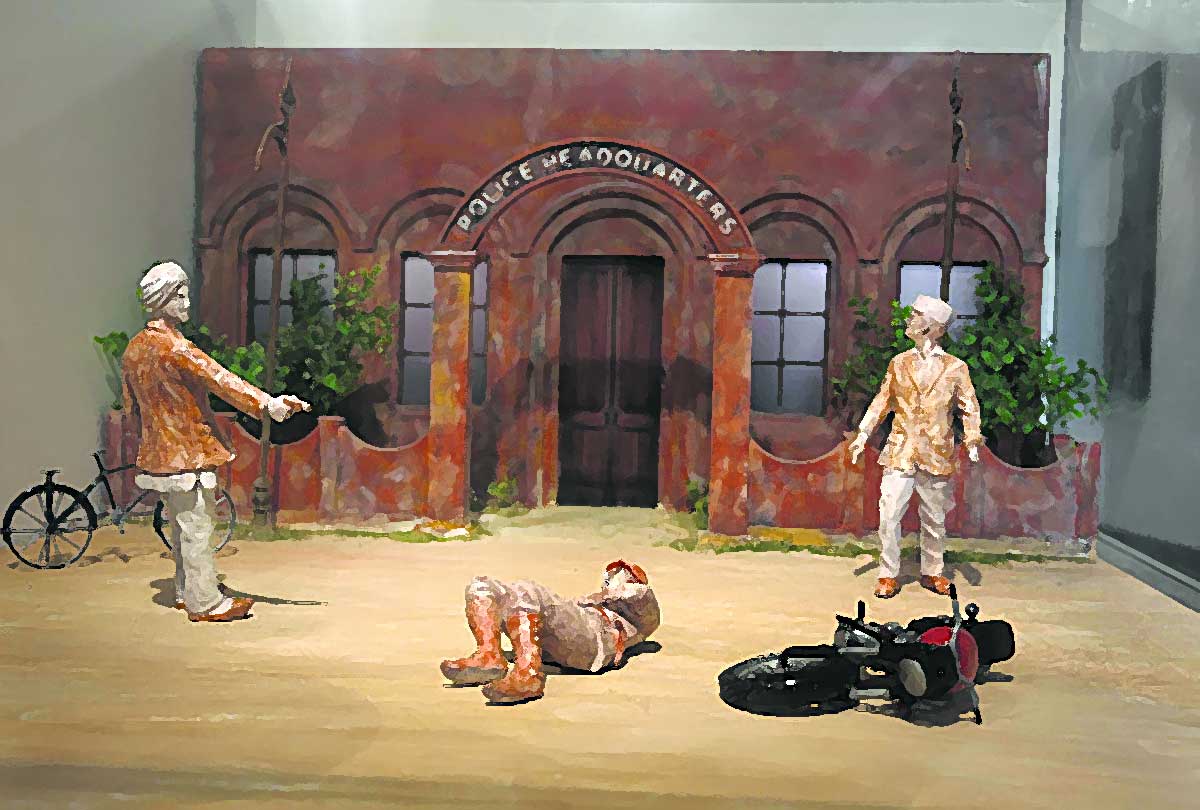 |
During their (Azad-Bhagat) conversation for few seconds to decide what should be the action. Rajguru thought otherwise; he did not want to miss an opportunity to hit the target and prove his creditability, he immediately ran towards the officer who was just start to move on Motor Cycle and fired a shot on the forehead of Saunders. Bhagat Singh heard the shot and ran up to dead officer and poured 4-5 shots from his pistol as he thought that it was his duty to kill the officer and his comrade might think him as coward.
If we go through the sketches being written by Shiv Kumar Verma about Raj Guru and Bhagat Singh every thing shall be cleared about, how both were eager to do the action every time when ever the situation arose.
And this race among themselves ran up to last movement of hanging. Same psychology prevailed in the mind of the Raj Guru, when he learned about the trial of Bhagat Singh has started under Section IPC 302 for murdering Saunders in July 1929. Till that time no one knew about second killer. Raj Guru did not want to hide and lose the credit as hero. So he himself offered to police at Poona in September 1929.
After killing Saunders, Bhagat Singh and Rajguru ran into DAV College Campus. A head constable of police Chanan Singh was after them. He was stopped by Azad himself and cautioned him to desist from chasing the young men, but Chanan Singh did not heed the warning and was ultimately shot dead by Azad's bullets. After that three escaped on bicycle safely and assembled at the fixed point.
The police was haunting the killer in every nook and corner of Lahore city but in vain, the version being given by the eyewitnesses about the identity of the culprits did not match with any known hard-core criminals nor resembled with other political history sheeters. Accordingly to the eye witnesses including Mr. Phern a traffic control inspector and others who testified in the trial case of Lahore Conspiracy-II case, one man who was running after shooting 4-5 shots, was very tall about six feet and having an English hat, a brown long coat with trouser and Black Derby's shoes. He was Bhagat Singh and about Raj Guru Witnesses described as follows, 'he wears a black Parsi Cap, Black short coat and Dhoti and sleeper in the feet'.
Thus it is very clear fact that Bhagat Singh had changed his body outlook well before the murder of Saunders and it is wrong that he cut his hairs and beard after the killing, secondly, when police was after him how he could take the risk to be shaved and dressed up freshly.
Further more Sohan Singh Josh's version about his meeting with Bhagat Singh and Sukhdev on that very night of December 17 is as follow.
"On the same night (17 December) a little after 11 P.M. some body knocked at my door in Bara Ghara, Islamabad. I was alone in the house, my family having gone to my village Chetanpura (Amritsar Distt.). I opened my door and to my utter surprise I found Bhagat Singh and Sukhdev standing outside along with bicycle. I welcomed them but told them that it was rather risky to have come to my house because the police might raid at any time. But Bhagat Singh said, Don't worry, we have made all arrangements. Give us something to eat".
They came in and said, "We are hungry"; I could offer two chapattis, some vegetable and a glass of milk. I told them we could cook fresh food. But they said, nothing doing, we shall take this and sleep" Bhagat Singh wearing a felt hat and an English style suit. Bhagat Singh took off his hat and placed it on a table nearby. He hung his pistol on a peg above the cot.
Above narration and trial court proceeding clearly shows that Bhagat Singh wore an English dress before the killing of Saunders and it is wrong notion that he cut down his hair after 17th December, as shown in all the Hindi Movies on Shaheed Bhagat Singh. Various reports of CID and Punjab police being sent by Govt of Punjab, to the Home Department of Govt, of British-India at Delhi and to Secretary of state for India in London, clearly showed the progress of investigation in Saunders murder Case. According to
various files (LPJ/1 2/377, S&G 58, 89-1928, P&J (S) 49 etc) police could not identify the killer up to April 6 1929. Only one man 'M' was claimed to be involve in the action. Who was Mr. 'M' and his identity reports did not say any thing. Only during the trial of case Mr. 'M' was declared as Rajguru, a Maratha from Distt. Poona.
On 18th & 19th December 1928 at least 16 persons were arrested on suspicion of involvement in that murder. The names of these 16 persons were; 1. Dr. Dharam Veer, 2. Hans Raj Vohra, 3. Dhanwantri, 4. Kedar Nath Sehgal, 5. Sant Ram Pandha, 6. Raj Kishore, 7. Mulla Abdul Mazid, 8. Mansoor Ahmad Khan, 9. Varinder (Later on he became the proprietor and Editor of "PARTAP" Jalandhar) 10. Hans Raj Sethi, 11. Ahmad Din, 12. Satya Varat, 13. Mir Mohmad Affjal, 14. Labhu Ram Partap, 15. Amolak Ram, and 16. Keshav Bhandu.
All the above persons were attached with Naujwan Bharat Sabha founded by Bhagat Singh in 1926 and Lahore Students Union and worker of Kirti Party. Sohan Singh Josh the committed communist and editor of a monthly magazine named "KIRTI", and also organized the Kirti Party in Punjab saw the brilliance of young Bhagat Singh and appointed him on the Editorial board of KIRTI where Bhagat Singh wrote many articles on the life of revolutionaries and various Independence struggles in India and abroad. Due to the views being written in those articles, differences were cropped up between Josh and Bhagat Singh, thus Bhagat Singh left the "KIRTI" and again joined the hardcore cadre of Hindustan Republic Army in 1928.
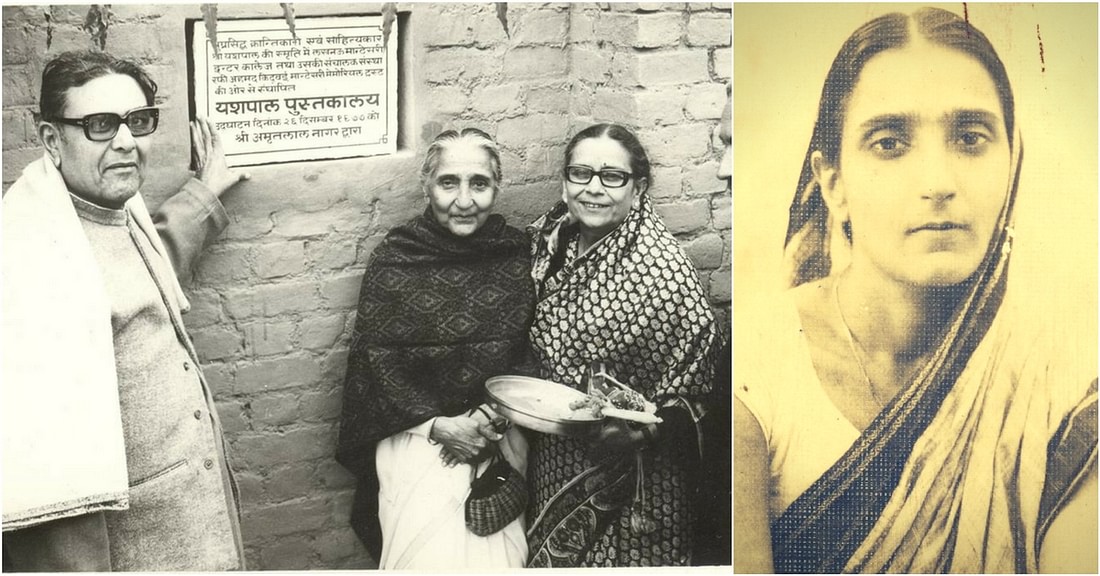 Durga Devi, who Helped Bhagat Singh Escape the British |
The police was working on the theory that those 16 persons were actively worked for the joint meeting that was held on 16th December 1928 to celebrate the martyr day of Kakori comrades. Nothing could be achieved from that arrest and ultimately all of them were released on bail by 29thDecember due to lack of evidences. During that period Bhagat Singh, Rajguru and Azad with the active & bold support of Durga Bhabhi escaped from Lahore safely on a train. While Azad went to Jhansi (MP), Rajguru to Poona and Durga Bhabhi, her son Sachin and Bhagat Singh reached Calcutta on 22nd Dec. 1928. The brain behind the evolution of Naujawan Bharat Sabha the husband of Durga Bhabhi and Mr. Bhagwati Charan Vohra was already in Calcutta to attend the proposed meeting to create a new joint working body of peasants and worker's party.
Here a question arises, when a person had already committed a crime and police was after it, what were the compulsions of that person or organisation to commit another action (Assembly Bomb) and offered himself for the arrest. Was any different purpose to be achieved? If any, could it be achieved through any other means? The answers to these questions made the difference between the approach and the achievements of two leaders namely Chander Shekhar Azad and Bhagat Singh.
Former was senior, bold and dare devil while the later was junior in the field and obedient worker of the organization. Azad believed in action and Bhagat Singh believe in achievement. Azad was influenced by old revolutionaries of UP esp. Ram Parsad Bismal, Ganesh Shankar Vidyarthi and Sachinder Sanyal, thus he thought and worked accordingly. While Bhagat Singh influenced by the revolutionaries of Ireland, France Russian and his Indian idol were Guru Gobind Singh (10th GURU OF SIKH), Shiva Ji (Marhatta) and of course young gadharites Kartar Singh Sarabha.
The killing of an English Officer to avenge the death of Lala Lajpat Rai was the brainwork of Azad. Bhagat Singh only obeyed the order of his Commander-in-Chief and after finishing the job they all were thinking accordingly. To understand this let us go to the story of Sohan Singh Josh when Bhagat Singh and Sukhdev came to his house on 17th December night.
After finishing the meal, the first question he (Bhagat Singh) shot at me (Josh) was," What is the reaction in general to Saunders murder?"
"The youth are happy", I replied. But they would have been much happier if Scott had been killed"
Bhagat Singh "We had gone there only for him but the other devil came out, and we could not go empty handed after all the pains taken for the preparation".
And then he added, "Any way, some beginning has been made"
There is another opinion also about this murder, I put in, and that is of Gandhi's followers.
We (Bhagat Singh) knew it before hand he said, "We discussed this before deciding upon the action" (a hint towards the point raised by Dalip Singh Alahabadi that Pt. Nehru was attached with the planning)
Then he contemptuously added "Gandhi stabbed the nation in the back by withdrawing the non-co-operation movement (1921-22) after the Chaura-Chori incident. The people are still under the cloud of frustration and demoralization which brought to this country".
But leave that aside; he continued "Do you know what has been the effect of Saunders murder on British Rulers?"
"I (Josh) do not know, it is too early to know that."
"There is a great panic among them," Bhagat Singh said, "Some of them have already booked their wives and children passages for England. They are terribly frightened."
"But this panic is temporary. It will wear off soon" Josh replied.
"What do you think of this action?" (Sohan Singh) I repeated what I had been saying," To this Bhagat Singh said, "I do not agree. This action will raise the masses and strengthen the movement".
During this whole talk Sukhdev did not utter a single word.
There were only two cots in the house. Sukhdev slept on one. Bhagat Singh and I shared the bigger one. A little before four they woke up in the morning to go.
According to Sohan Singh Josh he told them that he was going to Calcutta in the morning by train to take part in the first Joint Meeting of All India Peasant and Worker Party (This point may lead to Bhagat Singh and Sukhdev to make the planning to go to Calcutta).
If we analyses the above dialogues and public reaction after the murder of Saunders, there was no panic among the British as perceived by HSRA nor there was any celebration among the Indian.
Only few comments came from Pt. Moti Lai Nehru and Madan Mohan Malviya, other national leaders said nothing about the action. Even Bhagat Singh did not hear any thing about their action neither in the circle of Bengali Revolutionary, nor in the annual session of All India Congress Committee at Calcutta.
Bhagat Singh stayed at Calcutta for 2-3 weeks in December 1928 - January 1929 and met many Bengali Revolutionary and discussed in detail about the future planning. He might be disheartened to know that no one had appreciated his job. That made him to think otherwise and to chalk out the next action of Bomb throwing in the National Assembly. The idea was taken from the history of French Revolution, when an anarchist revolutionary leader of France Villaint throws a bomb in assembly chamber to "Make the deaf hear".
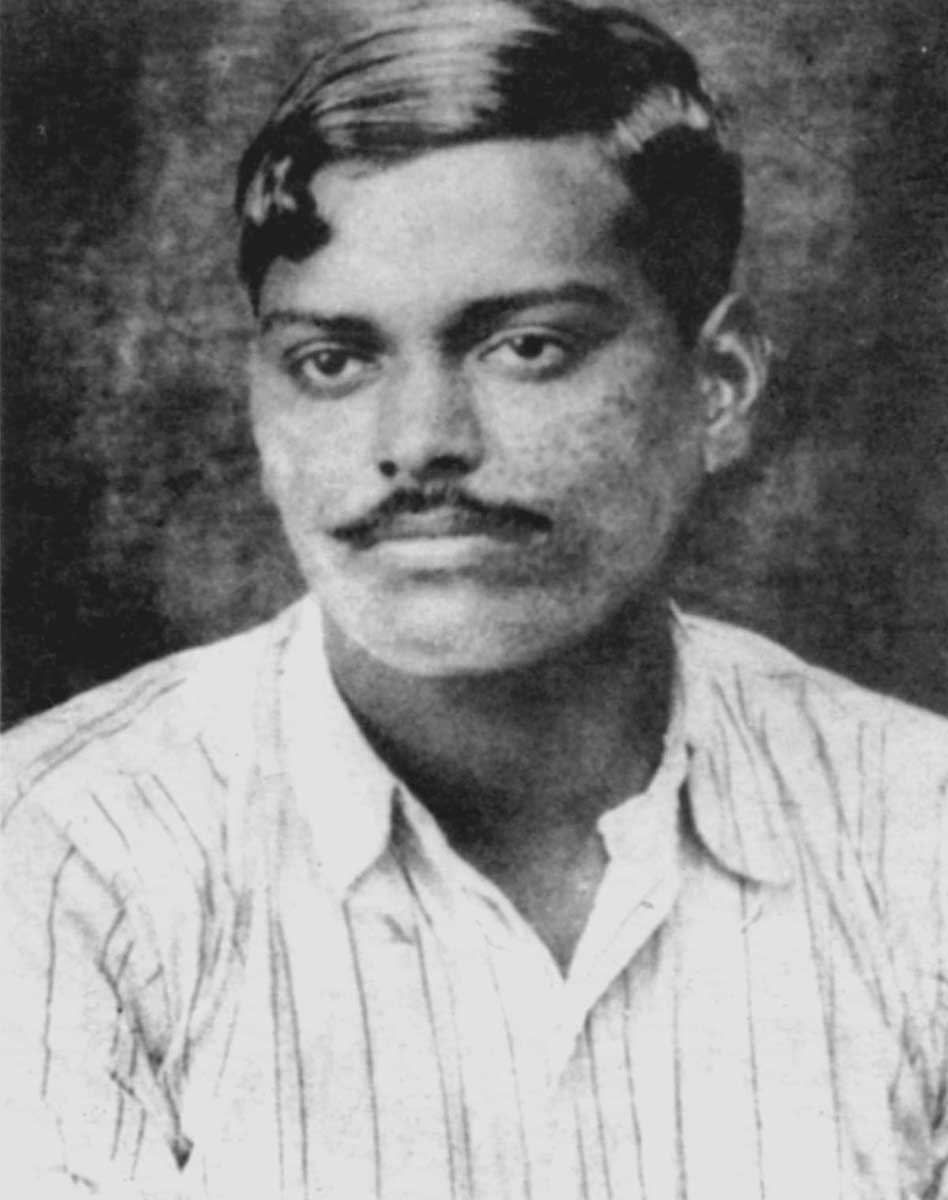 Chander Shekhar Azad |
Similarly when Chander Shekhar Azad had thought the aftermath of 17th December action he realized the futility of that action. He might be repenting on his planning which put his precious, brilliant comrade and a dear friend Bhagat Singh into great danger of execution when police would arrest him. That is why when Bhagat Singh returned from Calcutta in late January along with Jatindass & Phonirder Ghosh (Both expert in bomb making) and HSRA reassembled at Heing Mandi, Agra, the Commander-in-Chief readily
agreed on the future planning of bomb throwing but disagreed with the suggestion that Bhagat Singh would lead the action.
Azad did not want to loose Bhagat Singh by putting him into the hand of British Police. He recommended the names of Ram Saran Dass an old time Gadhariests and consisted of Lahore Conspiracy Case and Battu Keshwar Dutt, who was accepted by the Central Committee of Hindustan Socialist Republic Association. Sukhdev was not present in that meeting.
When Sukhdev met Bhagat Singh and came to know about the next action he did not agree with the idea. Both friends had discussed in detail about the idea and finally Sukhdev succeeded in persuading Bhagat Singh to call a fresh Meeting of Central Committee. In doing so, Sukhdev went to the extreme extent of blaming a close friend to ran away from death on account of Lady's love. Bhagat Singh rebuffed that he blamed him wrongly. Sukhdev replied "I am only cautioning a dear friend towards his duty."
What a climax, on one hand a friend (Sukhdev) was sending Bhagat Singh to death while another friend (Azad) was trying to save him from the hands of destiny. How long? At last logic and sense of duty prevailed upon the emotions and names were changed for the job. Thus Sukhdev has provided a chance for Bhagat Singh to become a true MARTYR.
Now it was the duty of Bhagat Singh to throw the bomb, to offer for police arrest and finally to defend themselves in light of their ideology of Socialism & Revolution. What happened on 8th April 1929 is a clear-cut history and every thing has gone accordingly but Bhagat Singh committed one great blunder. None had discussed about that blunder. Neither by any historian, nor by the revolutionaries, Only the top official of British intelligence and few Indian agents of that circle discussed in detail about that blunder. There was a hot discussion on the point "Why Bhagat Singh took his Pistol No. 168096 with him, when it was clear not to harm any body and offered for police arrest without any protest?."
That mistake of Bhagat Singh opened a ray of light for CID, which was working in dark on the murder of Saunders since 17th December 1928. According to Dalip Singh Alahabadi version was "GORA LOG BOHAT KHUSH THA!". English officers were very happy and discussed in detail how to make best use of that pistol to trap Bhagat Singh in the noose. There was a great pressure from few English Officers working at Lahore at that time. The investigating team of CID and police being led by (Aziz Ahemand) Khan recommended that a special expert in guns and explosive could be called from London.
A file pertaining to the formation and working of Intelligence Bureau in India clearly hints about that point. The report claimed that it has got success in pinpointing the relation between the shell of the gun fire found from the murder site and the Pistol No, 168096; further more report said that goldsmith named Robert Churchill was specially called from London, to made use of such expert for the first time.
Thus to take Pistol No. 168096 with him (Bhagat Singh) proved fatal and suicidal move and was a great blunder. If Bhagat Singh did not take his pistol with him on 8th April 1929 the police never succeeded, in proving him a murderer.
If we want to learn from the history then we have to analyze the pro and cons of every action of our old hero's. To shut the eyes from the mistake of our beloved ICON proved to be another mistake. Our intention is not to defame the Hero's but to caution the coming generation not to commit the same mistake. If we compare the two actions, one on 17th December 1928 and second of 8th April 1929, there were two apparent shades of one person namely Bhagat Singh, one who killed a man and second who spared the human lives from bomb. If we believe Dalip Singh Allahabadi version, Bhagat Singh was not involved in murder of Saunders. And if he was involved in direct killing what were his compulsions and under what circumstances he chose a path against his belief.
Accordingly to text of statement of Bhagat Singh being read in the court on 6th June, 1929 by Mr. Asaf Ali, Bhagat Singh said, "We are next to none in our love for humanity, far from having any malice against any individual, we hold human life sacred beyond words". It further state that, "we are neither perpetrators of dastardly outrages, and therefore, a disgrace to the country, as the pseudo-socialist Dewan Chaman Lai is reported to have described us, nor are we "LUNATICS" as the Tribune of Lahore and some others would have believed it."
"We bore no personal grudge or malice against anyone of those who received slight injuries or against any other person in the Assembly. On the contrary, we repeat that we hold human life sacred beyond words, and would sooner lay down our own lives in the service of humanity than injure anyone else. Unlike the mercenary soldiers of the imperialist armies who are disciplined to kill without compunction, we respect, and, in so far as it lies in our power, we attempt to save human life".
Although Asaf Ali read the above text but it was prepared and drafted by Bhagat Singh himself and Mr. Asaf Ali only polished the language. About this truth Mr. Asaf Ali claimed in an article being published on March 23, 1949 in a Journal "Common Weal" published from Poona.
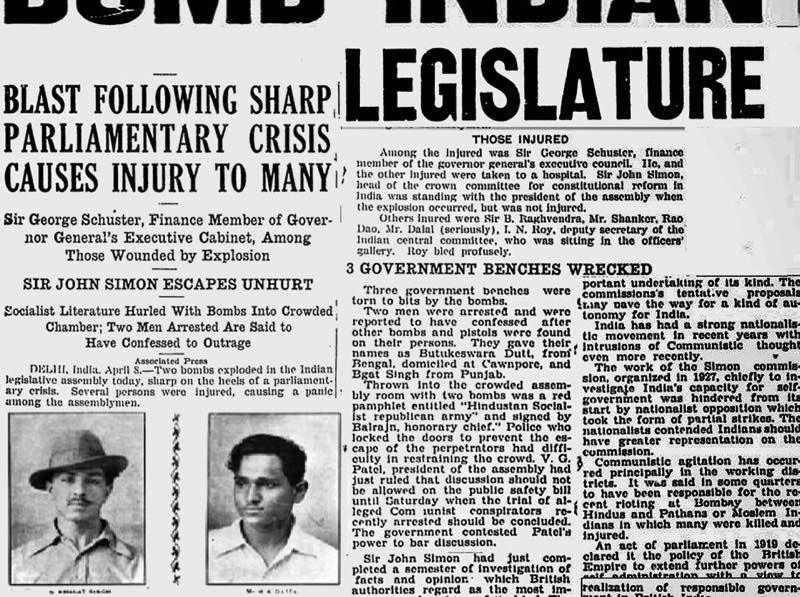 Bhagat Singh & Batukeshwar Dutt dropped two bombs in the central legislative assembly |
So when a man has had such a great value for human life how he could prepare himself for killing a man. Has Bhagat Singh changed his mind after 17th December 1928, killing or he was telling a lie in his statement? No, not at all, he was telling the truth and he has a great respect for human life.
What Dalip Singh Alahabadi has told to Mr., Kulwant Singh Kooner is worthwhile to think upon that hidden truth and when we will go through other secrets being told by Allahabadi then one has to research the whole history about Bhagat Singh ERA.
Before unveiling the hidden truth I recalled, "Why I am an Atheist" being written by the Martyr himself on 4-5 October 1930, just two days before the pronouncement of judgment by the special tribunal. Bhagat Singh wrote, "You go and oppose the prevailing faith, you go and criticize a hero, a great man who is generally believed to be above criticism because he is thought to be infallible, the strength of your argument shall force the multitude to decry you as vainglorious."
Bhagat Singh is a great Hero for many Indians even after 75 years. His presence is being felt everywhere. In many Cities and Towns statue of Bhagat Singh are standing on important road crossing, various sports tournaments and cultural festivals are held in rural area in school and colleges. Bhagat Singh became a legend, a hero, a great man above criticism thus a story of "Hidden Truth" is put to test before the readers and critics.
"Any man who stands for progress has to criticize, disbelieve and challenge every item of the old faith. Item by item he has to reason out every nook and corner of the prevailing faith. If after considerable reasoning one is led to believe in any theory or philosophy his faith is welcomed. His reasoning can be mistaken, wrong, misled and some times fallacious. But he is liable to correction because reason is the guiding star of his life. But mere faith and blind faith is dangerous. It dulls the brain, and makes a man reactionary. A man who claims to be a realist has to challenge the whole of the ancient faith. If it does not stand to the onslaught of reason it crumbles down — "(Why I am an Atheist)
Source:
Martyrdom of Shaheed Bhagat Singh - Secrets unfold by an Intelligence Bureau Agent of British-India - by Kulwant Singh Kooner Gurpreet Singh Sindhra
 Support Us
Support Us
Satyagraha was born from the heart of our land, with an undying aim to unveil the true essence of Bharat. It seeks to illuminate the hidden tales of our valiant freedom fighters and the rich chronicles that haven't yet sung their complete melody in the mainstream.
While platforms like NDTV and 'The Wire' effortlessly garner funds under the banner of safeguarding democracy, we at Satyagraha walk a different path. Our strength and resonance come from you. In this journey to weave a stronger Bharat, every little contribution amplifies our voice. Let's come together, contribute as you can, and champion the true spirit of our nation.
 |  |  |
| ICICI Bank of Satyaagrah | Razorpay Bank of Satyaagrah | PayPal Bank of Satyaagrah - For International Payments |
If all above doesn't work, then try the LINK below:
Please share the article on other platforms
DISCLAIMER: The author is solely responsible for the views expressed in this article. The author carries the responsibility for citing and/or licensing of images utilized within the text. The website also frequently uses non-commercial images for representational purposes only in line with the article. We are not responsible for the authenticity of such images. If some images have a copyright issue, we request the person/entity to contact us at This email address is being protected from spambots. You need JavaScript enabled to view it. and we will take the necessary actions to resolve the issue.
Related Articles
- Our first true war of independence lie forgotten within the fog of time and tomes of propaganda: Sanyasi Rebellion, when "renouncers of the material world" lead peasants in revolt against British and fundamentalist islamic clans
- Vinayak Damodar Savarkar – A Misunderstood Legacy
- Kartar Singh Sarabha - The Freedom fighter who was Hanged at the age of 19 and inspired Bhagat Singh
- Cross Agent and the hidden truth of massacre of Jallianwala Bagh - Martyrdom of Shaheed Bhagat Singh (Some Hidden Facts)
- Godse's speech and analysis of fanaticism of Gandhi: Hindus should never be angry against Muslims
- Northeast is not the Part of Pakistan because of 'Netaji': Subhas Bose and the ‘special’ case of Assam
- Anuj Dhar claims that Subhas Chandra Bose was suspected of being ‘poisoned’ after ouster from the post of Congress president
- Bhagat Irwin Gandhi - Martyrdom of Shaheed Bhagat Singh (Some Hidden Facts)
- Gandhi emphasized that he won't salute Indian National Flag if Charkha is replaced by Ashoka Chakra and wanted British flag added to it
- Father of the Nation! Absolutely not. Mohandas Karamchand Gandhi was not the father of the nation either officially or otherwise
- A troubled childhood - Rajguru: The Invincible Revolutionary
- Nehru's Himalayan Blunders which costed India dearly - Integration of Princely States
- Martyrs’ march into the history - Rajguru: The Invincible Revolutionary
- Santi Ghosh and Suniti Choudhury: Two Teenage Freedom Fighters Assassinated British Magistrate
- When Secular Nehru Opposed Restoration Of Somnath Temple - The Somnath Temple treachery





















